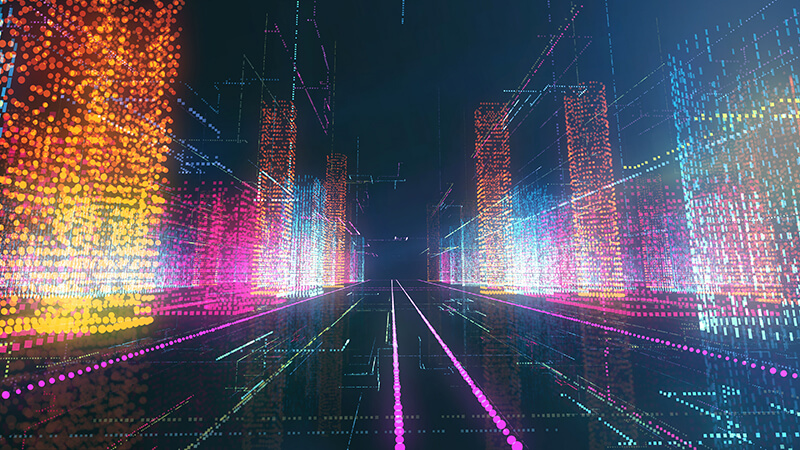December 10, 2019
What if a bridge could prevent its own collapse in real time?
New center to bring intelligent infrastructure that adapts to humans’ needs
 Intelligent infrastructure would enable roads, bridges and buildings to respond on their own during natural disasters and other catastrophic events, avoiding failure. (iStock photo not available for download)
Intelligent infrastructure would enable roads, bridges and buildings to respond on their own during natural disasters and other catastrophic events, avoiding failure. (iStock photo not available for download)
WEST LAFAYETTE, Ind. —Several major bridges have collapsed worldwide in 2019, ranging from a pedestrian bridge in Miami, killing six people, to a towering arch bridge in Taiwan dumping a truck onto boats below.
The trend will likely continue: More than 47,000 bridges in the U.S. are structurally deficient, a report found earlier this year.
A new Center for Intelligent Infrastructure (CII) at Purdue University is bringing together researchers of various fields to develop technology that a bridge, building, road or other infrastructure could use to communicate directly with humans and respond to disasters, preventing collapse.
“Intelligent infrastructure would be able to understand human needs and autonomously adapt to them,” said Luna Lu, the director of CII and an associate professor in Purdue’s Lyles School of Civil Engineering. “The goal of our center is to advance knowledge and education in the intelligent infrastructure space.”
The center unites the expertise of Purdue researchers in smart materials, construction, infrastructure resiliency and policy, sensing, system control, data optimization, communication, machine learning and artificial intelligence.
“We want to tackle the fundamental problems in making infrastructure more intelligent,” said Shaoshuai Mou, the associate director of CII and an assistant professor of aeronautics and astronautics at Purdue.
Several projects are already underway, including sensors that live in concrete to monitor the health and strength of pavement in real time. Data from the sensors can help inform the optimal time to open up traffic after a patching project and continuously track concrete development.
Other technology also will focus on making various aspects of infrastructure more autonomous, adaptable and sustainable.
Hubo Cai, a Purdue associate professor of civil engineering and construction engineering and management, is leading work on replicating construction processes using virtual reality and ways that operators could remotely control machines.
Ultrasonic transducers fabricated on large-area flexible and transparent substrates are being developed in the HybridMEMS Lab, led by Dana Weinstein, a Purdue associate professor of electrical and computer engineering. Both individual transducers and large-area arrays could be implemented at low cost for monitoring structural and environmental health, traffic and peer-to-peer communication in networks of these sensors.
“We would like to see ubiquitous deployment of such systems for intelligent infrastructure,” Weinstein said.
Expertise from Purdue’s Krannert School of Management will advise on how to tailor technology developed through the center to industry needs. CII plans to foster collaborations between academia, federal agencies and the private sector as part of a Purdue Engineering Initiative in Autonomous and Connected Systems.
“The Center for Intelligent Infrastructure is well positioned to become a world-leading research center in the evolution of how we live,” said Mung Chiang, Purdue’s John A. Edwardson Dean of the College of Engineering. “We are excited about the fundamental research and societal impact of this center, as well as other programs in the Purdue Engineering Initiative in Autonomous and Connected Systems. We also applaud the interdisciplinary team across multiple schools and colleges at Purdue.”
In addition to developing the technology itself, the center will investigate the policy and social barriers to the technology’s adoption and provide educational opportunities, such as online courses, seminars and workshops, and community outreach.
The researchers also want to extend solutions to rural areas, allowing infrastructure to develop alongside a transition to autonomous transportation.
“Rural areas are at the heart of manufacturing. Imagine having autonomous trucks, but no wireless connectivity. How would they deliver without the infrastructure to support them?” Lu said.
Each research area of the center is led by core faculty, including Vaneet Aggarwal in machine learning, Jianghai Hu in control and optimization, Roshanak Nateghi and Hubo Cai in sustainability and resiliency, and Tyler Tallman in sensor development.
Writer: Kayla Wiles, 765-494-2432, wiles5@purdue.edu
Sources: Luna Lu, 765-494-5842, luna@purdue.edu
Shaoshuai Mou, 765-494-2546, mous@purdue.edu
Dana Weinstein, 765-496-3647, danaw@purdue.edu
